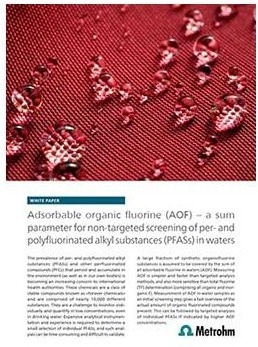Per- and polyfluorinated alkyl substances (PFASs) are the class of almost 10,000 manmade organofluorine compounds more commonly known as «forever chemicals». PFASs are resistant to water, oil, and heat. Due to their unique properties, they find widespread applications in many products and industries. They can enter the water supply and the food chain, causing various health problems in humans.

Image Credit: Metrohm Middle East FZC
The stability of these substances and their decay products, combined with their affinity to bind to proteins, makes them especially harmful. Targeted analysis methods only capture a small fraction of the variety of PFASs. Non-targeted screening methods offer a more comprehensive view of water quality by estimating the overall impact of organofluorine substances.
Despite research and regulations on longer-chain PFASs (e.g., perfluorooctanoic acid, PFOA, and perflurooctane sulfonic acid, PFOS), new formulations for chemicals with similar properties are released on a regular basis. Health effects for most of these «forever chemicals» are poorly understood, as it can take several years to prove any relationship between exposure and any resulting impacts.
The EU Directive 2020/2184 suggests a maximum value of 0.50 μg/L for total PFASs or 0.10 μg/L for longer chain PFASs as a minimum requirement to assess the quality of water intended for human consumption. Several norms are already in place for the targeted determination of a few PFASs known to cause significant harm to humans and the environment (e.g., ASTM D7979, US EPA Methods 533, 537.1, and SW-846). However, the majority of these harmful substances are not covered with such analyses.
Comprehensive screening methods such as the determination of the sum parameter adsorbable organic fluorine (AOF) with combustion ion chromatography (CIC) may be a better choice to monitor the full scope of synthetic organic fluorine compounds present in water samples. AOF measurement can be especially helpful to monitor the efficiency of water treatment processes for removing harmful synthetic organofluorine chemicals and prevent their release into the environment or to the general water supply. It is also a good indicator to initiate detailed targeted analyses if values are high.
Compared to targeted analysis methods that measure only a small selection of individual compounds, the determination of AOF in water samples with combustion ion chromatography is:
- More comprehensive
- More robust
- Easier to perform
- A fast, inexpensive screening alternative
Download the white paper to learn more about the determination of AOF as a screening method for PFASs in water samples